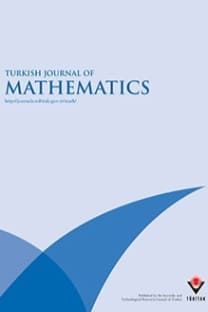Mathematical analysis of local and global dynamics of a new epidemic model
Mathematical analysis of local and global dynamics of a new epidemic model
___
- [1] Adebimpe O, Bashiru KA, Ojurongbe TA. Stability analysis of an SIR epidemic with non-linear incidence rate and treatment. Open Journal of Modelling and Simulation 2015; 3 (3): 104-110.
- [2] Aghdaoui H, Alaoui AL, Nisar KS, Tilioua M. On analysis and optimal control of a SEIRI epidemic model with general incidence rate. Results in Physics 2021; 20: 1-9.
- [3] Ak Gümüş Ö. Global and local stability analysis in a nonlinear discrete-time population model. Advances in Difference Equations 2014; 299: 1-9.
- [4] Butler G, Waltman P. Persistence in dynamical systems. Journal of Differential Equations 1986; 63: 255-263
- [5] Chatibi Y, El Kinani EH, Ouhadan A. Lie symmetry analysis of conformable differential equations. AIMS Mathematics 2019; 4 (4): 1133-1144.
- [6] Chatibi Y, El Kinani EH, Ouhadan A. Lie symmetry analysis and conservation laws for the time fractional BlackScholes equation. International Journal of Geometric Methods in Modern Physics 2020; 17 (1): 1-14.
- [7] Chatibi Y, El Kinani EH, Ouhadan A. On the discrete symmetry analysis of some classical and fractional differential equations. Mathematical Methods in the Applied Sciences 2021; 44 (4): 2868-2878.
- [8] Coppel WA. Stability and asymptotic behavior of differential equations. Boston: Heath, 1965.
- [9] Çakan S. Dynamic analysis of a mathematical model with health care capacity for COVID-19 pandemic. Chaos, Solitons and Fractals 2020; 139: 1-8.
- [10] Çay İ. On the local and global stability of an sirs epidemic model with logistic growth and information intervention. Turkish Journal of Mathematics 2021; 45 (4): 1668-1677.
- [11] Diekmann O, Heesterbeek JAP, Metz JAJ. On the definition and the computation of the basic reproduction ratio R0 in models for infectious diseases in heterogeneous populations. Journal of Mathematical Biology 1990; 28 (4): 365-382.
- [12] Driessche PVD, Watmough J. Reproduction numbers and sub-threshold endemic equilibria for compartmental models of disease transmission. Mathematical Biosciences 2002; 180: 29-48.
- [13] Elazzouzi A, Alaoui AL, Tilioua M, Torres DFM. Analysis of a SIRI epidemic model with distributed delay and relapse. Statistics, Optimization and Information Computing 2019; 7 (3): 545-557.
- [14] Elazzouzi A., Alaoui AL, Tilioua M, Tridane A. Global stability analysis for a generalized delayed SIR model with vaccination and treatment. Advances in Difference Equations 2019; 532: 1-19.
- [15] Freedman HI, Ruan S, Tang M. Uniform persistence and flows near a closed positively invariant set. Journal of Dynamics and Differential Equations 1994; 6 (4): 583-600.
- [16] Gökçe A, Yazar S, Şekerci Fırat Y. Delay induced nonlinear dynamics of oxygen-plankton interactions. Chaos, Solitons and Fractals 2020; 141: 1-13.
- [17] Gölgeli M, Atay FM. Analysis of an epidemic model for transmitted diseases in a group of adults and an extension to two age classes. Hacettepe Journal of Mathematics and Statistics 2020; 49 (3): 921-934.
- [18] Joshi H, Sharma RK, Prajapati GL. Stability analysis of a deterministic vaccination model with non-monotonic incidence rate. Journal of Mathematics and Computer Science 2020; 10 (1): 51-67.
- [19] Kermack WO, Mckendrick AG. A contributions to the mathematical theory of epidemics. Proceedings of the Royal Society A 1927; 115: 700-721.
- [20] Khalil HK. Nonlinear Systems. Upper Saddle River, NJ: Prentice Hall, 2002.
- [21] Lakshmikantham S, Leela S, Martynyuk AA. Stability analysis of nonlinear systems. New York: Marcel Dekker, Inc., 1989.
- [22] LaSalle JP. The stability of dynamical systems. CBMS-NSF Regional Conference Series in Applied Mathematics, Philadelphia: SIAM, 1976.
- [23] Li MY, Graef JR, Wang LC, Karsai J. Global dynamics of a SEIR model with a varying total population size. Mathematical Biosciences 1999; 160 (2): 191-213.
- [24] Li M, Muldowney J. A geometric approach to global stability problems. SIAM Journal on Mathematical Analysis 1996; 27 (4): 1070-1083.
- [25] Ma W, Takeuchi Y, Hara T, Beretta E. Permanence of an SIR epidemic model with distributed time delays. Tohoku Mathematical Journal 2002; 54: 581-591.
- [26] Ojo MM, Akinpelu FO. Lyapunov functions and global properties of SEIR epidemic model. International Journal of Chemistry, Mathematics and Physics 2017; 1 (1): 11-16.
- [27] Şekerci Fırat Y, Özarslan R. Dynamic analysis of time fractional order oxygen in a plankton system. European Physical Journal Plus 2020; 135 (1): 1-13.
- [28] Tehrani NF, Razvan MR, Yasaman S. Global analysis of a delay SVEIR epidemiological model. Iranian Journal of Science and Technology, Transaction A: Science 2013; 37 (4): 483-489.
- [29] Waltman P. A brief survey of persistence in dynamical systems. In: Busenberg S, Martelli M, (eds) Delay Differential Equations and Dynamical Systems. Lecture Notes in Mathematics, vol 1475. Berlin, Heidelberg: Springer, 1991, pp. 31-40.
- [30] Wang L, Li MY, Kirschner D. Mathematical analysis of the global dynamics of a model for HTLV-I infection and ATL progression. Mathematical Biosciences 2002; 179: 207-217.
- ISSN: 1300-0098
- Yayın Aralığı: 6
- Yayıncı: TÜBİTAK
Scattering properties of impulsive difference Dirac equations
Mathematical analysis of local and global dynamics of a new epidemic model
Scattering theory of the quadratic eigenparameter depending impulsive Sturm–Liouville equations
Elgiz BAIRAMOV, Güler Başak ÖZNUR
Rajendran MAHENDRAN, Veerasamy SUBBURAYAN
Boundary value problems for a second-order (p, q)-difference equation with integral conditions
Ducival Carvalho PEREIRA, Adriano Pedreira CATTAI, Carlos Alberto RAPOSO
Mahammad KHUDDUSH, Kapula Rajendra PRASAD
Two nonzero weak solutions for a quasilinear Kirchhoff type problem
